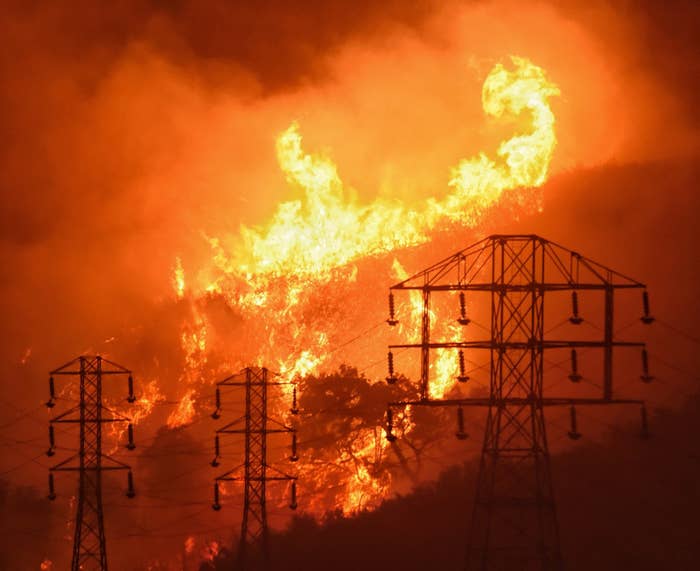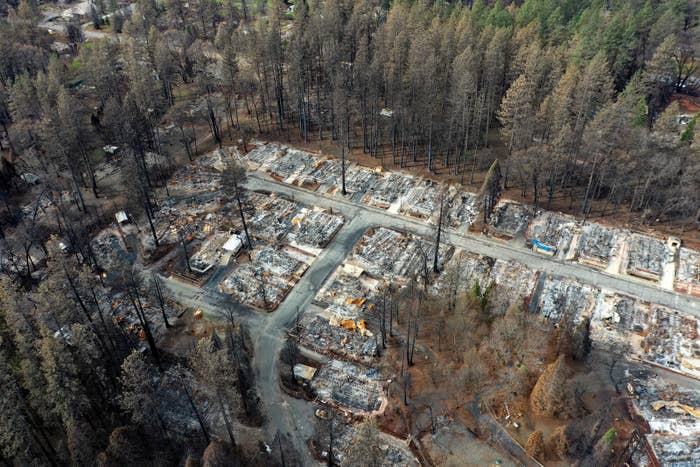
LOS ANGELES — A month after filing for bankruptcy over its role in igniting several devastating wildfires in California, the nation's largest utility company announced Thursday that it was likely responsible for the deadliest blaze in state history.
Pacific Gas and Electric, which faces billions of dollars in payouts to hundreds of wildfire victims, said that it "believes it is probable that its equipment will be determined to be an ignition point" for the Camp fire, which killed at least 85 people and destroyed 14,000 homes in November, reducing the Northern California town of Paradise basically to ashes.
It is the first time the embattled power provider has officially acknowledged it will most likely be found at fault for starting the fire, stating that although the investigation is still ongoing, based on its information and what has been reported to the California Public Utilities Commission and other agencies, the company believes issues with its equipment ignited the deadly blaze in the rural foothill town of Pulga on Nov. 8.
When it filed for bankruptcy protection in January, the utility giant cited the overwhelming, expensive, and "grave" task of trying to adapt its power grid to handle the state's climate change–fueled, record-breaking fires that have thrust California into a "new abnormal" of nearly year-round fire weather.
State fire officials and investigators have already determined that PG&E's equipment has started about 17 wildfires, some of which killed residents, over the past few years. Hundreds of victims from all over the state have filed lawsuits against the company, accusing it of negligently and irresponsibly letting its equipment age and get too close to dry brush and vegetation encircling many vulnerable communities.

PG&E had estimated that the onslaught of these wildfire-related liabilities could top $30 billion. And now, with the addition of the Camp fire, the company said it was taking an $11.5 billion charge against its 2018 earnings.
The beleaguered power company had previously stated that it could be liable for the Camp fire, but Thursday's disclosure, folded into its financial report, painted a more in-depth look at its involvement. The California Department of Forestry and Fire Protection (Cal Fire) and the state Public Utilities Commission is still investigating the cause and would not comment on PG&E's disclosure.
Cal Fire had reported that the fire started near a transmission tower in Pulga, along the company's 115-kilovolt Caribou-Palermo line, at at 6:33 a.m. on Nov. 8, 2018.
Fifteen minutes before the blaze sparked, PG&E reported that the line went down and then shortly after, an employee saw flames near one of the towers. At 6:45 a.m. another circuit on the line had a power failure.
About a week after the Camp fire tore through the town, PG&E and fire officials went to the origin point to investigate and found a broken C-hook attached to a separated suspension insulator, a "flash mark" on the tower, along with "wear at the connection point" and other damage to some poles.
After the fire, PG&E took the Caribou-Palermo complex off-line and, in December, de-energized all 56 miles of the line.
For years, however, the aging Caribou-Palermo line has been in need of wide-ranging repairs, according to state and federal filings and regulatory reports. However, the company did not schedule large-scale upgrades until December 2018, a month after the equipment malfunctioned and likely sparked the Camp fire.
In 2013, PG&E told the state in a letter about its plan to repair towers damaged in a 2012 storm and other maintenance work, which the company said it finally completed three years later.
In 2017, PG&E acknowledged to the Federal Energy Regulatory Commission that the line needed substantial work and improvements, citing a study from years earlier that identified more than 120 clearance issues between lines, lines and structures, and lines and the ground. The company outlined its plan to replace and repair towers, frames, and poles.
Documents submitted to California's public utility commission, which oversees PG&E, show that energy officials had flagged the system in 2010 and 2015.
"The California Independent System Operator transmission plan identified the need to improve and upgrade this system to address potential overloads and power outages that would affect customers in the service area,” a PUC filing stated in 2017, while again outlining the need to update the transmission complex.
James Noonan, a PG&E spokesperson, explained that the tower at the center of the Camp fire had not been part of the 2017 report and that the clearance upgrades outlined in the federal filing were different than maintenance and other repairs flagged years before, some of which the company completed in 2016, he said.
"It's a very complex issue and there have been entirely separate projects on different stretches of the line," Noonan said, explaining that there are currently inspections and safety upgrades occurring along the company's 5,500 miles of transmission lines.
“The company is taking action right away to address any issues that pose an immediate risk to public safety, in advance of this year’s wildfire season," the company said in a statement. It "expects to complete the remaining inspections of its electric transmission lines by the end of March 2019, pending any weather or access constraints.”

Jody Jones, the mayor of Paradise, said that if officials at PG&E had been “deferring maintenance on equipment to give shareholders dividends, they should be held accountable.”
But she stressed PG&E workers have been integral during the long, difficult recovery process.
“There are 3,000 of them living in tents for months restoring power to our town. They have sacrificed time with their families and their own comfort to help get us back,” she said. “But when the PG&E announcement came out, people were throwing rocks at them and it’s a shame because, for us, these people are heroes."
Still, energy experts and former members of the state's public utility commission, which oversees PG&E, say that the company's decision to continuously delay repairs on the line raises red flags as to how the company was using money and resources.
"It raises questions as to whether PG&E is adequately staffing its work in this area," Steven Weissman, a professor with University of California, Berkeley’s Goldman School of Public Policy and former adviser to CPUC, told Mercury News.
CPUC has remained mum over PG&E's decision to delay repairs, saying in a statement that it continues to examine "the role that PG&E assets may have played in the ignition of the fire."
"The CPUC investigations of major incidents such as the Camp Fire typically include a broad range of issues pertaining to safety of utility operations and root cause of the incident, including historic maintenance and expenditures," said spokesperson Terrie Prosper.
However, Loretta Lynch, a former commissioner, criticized the utility commission's long and troublingly cozy relationship with PG&E, telling Mercury News that the CPUC acts more like a "lapdog not a watchdog when it comes to PG&E."
“The PUC has let PG&E get away with anything it wants," she said.
On Thursday, the power provider told investors that it has "substantial doubt" about its future.
"The company is facing extraordinary challenges relating to the 2018 Camp Fire and 2017 Northern California wildfires," it said, explaining that it does not think it will be able to "continue as going concerns."

